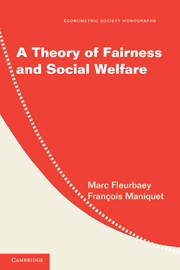5 - Fair Distribution of Divisible Goods: Two Approaches
Published online by Cambridge University Press: 05 January 2013
Summary
INTRODUCTION
This chapter and the next one pursue the analysis of the model that provided the framework of Part I. Our aim now is to obtain precise conclusions about how to rank allocations. We already know from Chapter 3 that a good deal of egalitarianism is necessarily part of the picture, but it remains to be determined how individual situations should be measured and compared with one another.
Among a variety of options, two main social orderings are highlighted here. One has already been introduced in Chapter 1 – namely, the Ω-equivalent leximin SOF. Another one also appears salient, and is more closely connected to the market mechanism. The choice between one or the other of these two different SOFs can be made easier, we hope, with the results of this chapter that show how they derive from different ethical principles.
In the next section, a first series of results highlight the Ω-equivalent leximin SOF on the basis of axioms focusing on the equal split of the available resources. In Section 5.3, the alternative approach of a Walrasian kind of social preferences is introduced and motivated on the basis of axioms that relate to responsibility and neutrality (with respect to individual preferences) and to efficiency. Section 5.4 shows how these social ordering functions can be used for the selection of allocations in the second-best context in which the policymaker does not know individuals' characteristics but has information about the statistical distribution of characteristics.
- Type
- Chapter
- Information
- A Theory of Fairness and Social Welfare , pp. 75 - 97Publisher: Cambridge University PressPrint publication year: 2011



